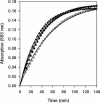Kinetic analysis of the oxidative conversion of the [4Fe-4S]2+ cluster of FNR to a [2Fe-2S]2+ Cluster
- PMID: 15547274
- PMCID: PMC529072
- DOI: 10.1128/JB.186.23.8018-8025.2004
Kinetic analysis of the oxidative conversion of the [4Fe-4S]2+ cluster of FNR to a [2Fe-2S]2+ Cluster
Abstract
The ability of FNR to sense and respond to cellular O(2) levels depends on its [4Fe-4S](2+) cluster. In the presence of O(2), the [4Fe-4S](2+) cluster is converted to a [2Fe-2S](2+) cluster, which inactivates FNR as a transcriptional regulator. In this study, we demonstrate that approximately 2 Fe(2+) ions are released from the reaction of O(2) with the [4Fe-4S](2+) cluster. Fe(2+) release was then used as an assay of reaction progress to investigate the rate of [4Fe-4S](2+) to [2Fe-2S](2+) cluster conversion in vitro. We also found that there was no detectable difference in the rate of O(2)-induced cluster conversion for FNR free in solution compared to its DNA-bound form. In addition, the rate of FNR inactivation was monitored in vivo by measuring the rate at which transcriptional regulation by FNR is lost upon the exposure of cells to O(2); a comparison of the in vitro and in vivo rates of conversion suggests that O(2)-induced cluster conversion is sufficient to explain FNR inactivation in cells. FNR protein levels were also compared for cells grown under aerobic and anaerobic conditions.
Figures







Similar articles
-
Reversible cycling between cysteine persulfide-ligated [2Fe-2S] and cysteine-ligated [4Fe-4S] clusters in the FNR regulatory protein.Proc Natl Acad Sci U S A. 2012 Sep 25;109(39):15734-9. doi: 10.1073/pnas.1208787109. Epub 2012 Sep 10. Proc Natl Acad Sci U S A. 2012. PMID: 23019358 Free PMC article.
-
Iron-sulfur cluster disassembly in the FNR protein of Escherichia coli by O2: [4Fe-4S] to [2Fe-2S] conversion with loss of biological activity.Proc Natl Acad Sci U S A. 1997 Jun 10;94(12):6087-92. doi: 10.1073/pnas.94.12.6087. Proc Natl Acad Sci U S A. 1997. PMID: 9177174 Free PMC article.
-
Superoxide destroys the [2Fe-2S]2+ cluster of FNR from Escherichia coli.Biochemistry. 2004 Jan 27;43(3):791-8. doi: 10.1021/bi0357053. Biochemistry. 2004. PMID: 14730984
-
Oxygen sensing by the global regulator, FNR: the role of the iron-sulfur cluster.FEMS Microbiol Rev. 1998 Dec;22(5):341-52. doi: 10.1111/j.1574-6976.1998.tb00375.x. FEMS Microbiol Rev. 1998. PMID: 9990723 Review.
-
Reactions of nitric oxide and oxygen with the regulator of fumarate and nitrate reduction, a global transcriptional regulator, during anaerobic growth of Escherichia coli.Methods Enzymol. 2008;437:191-209. doi: 10.1016/S0076-6879(07)37011-0. Methods Enzymol. 2008. PMID: 18433630 Review.
Cited by
-
Iron-sulfur clusters are involved in post-translational arginylation.Nat Commun. 2023 Jan 28;14(1):458. doi: 10.1038/s41467-023-36158-z. Nat Commun. 2023. PMID: 36709327 Free PMC article.
-
Characterization of [4Fe-4S]-containing and cluster-free forms of Streptomyces WhiD.Biochemistry. 2009 Dec 29;48(51):12252-64. doi: 10.1021/bi901498v. Biochemistry. 2009. PMID: 19954209 Free PMC article.
-
Deletion of genes encoding cytochrome oxidases and quinol monooxygenase blocks the aerobic-anaerobic shift in Escherichia coli K-12 MG1655.Appl Environ Microbiol. 2010 Oct;76(19):6529-40. doi: 10.1128/AEM.01178-10. Epub 2010 Aug 13. Appl Environ Microbiol. 2010. PMID: 20709841 Free PMC article.
-
The O2 sensitivity of the transcription factor FNR is controlled by Ser24 modulating the kinetics of [4Fe-4S] to [2Fe-2S] conversion.Proc Natl Acad Sci U S A. 2009 Mar 24;106(12):4659-64. doi: 10.1073/pnas.0804943106. Epub 2009 Mar 4. Proc Natl Acad Sci U S A. 2009. PMID: 19261852 Free PMC article.
-
Transcriptome-Level Signatures in Gene Expression and Gene Expression Variability during Bacterial Adaptive Evolution.mSphere. 2017 Feb 15;2(1):e00009-17. doi: 10.1128/mSphere.00009-17. eCollection 2017 Jan-Feb. mSphere. 2017. PMID: 28217741 Free PMC article.
References
-
- Agashe, V. R., S. Guha, H. C. Chang, P. Genevaux, M. Hayer-Hartl, M. Stemp, C. Georgopoulos, F. U. Hartl, and J. M. Barral. 2004. Function of trigger factor and DnaK in multidomain protein folding: increase in yield at the expense of folding speed. Cell 117:199-209. - PubMed
-
- Bates, D. M. 1999. Role of iron-sulfur cluster conversion in the oxygen-sensing mechanism of the Escherichia coli transcription factor FNR. Ph.D. thesis. University of Wisconsin—Madison, Madison.
-
- Bates, D. M., C. V. Popescu, N. Khoroshilova, K. Vogt, H. Beinert, E. Münck, and P. J. Kiley. 2000. Substitution of leucine 28 with histidine in the Escherichia coli transcription factor FNR results in increased stability of the [4Fe-4S]2+ cluster to oxygen. J. Biol. Chem. 275:6234-6240. - PubMed
-
- Beinert, H. 1983. Semi-micro methods for analysis of labile sulfide and of labile sulfide plus sulfane sulfur in unusually stable iron-sulfur proteins. Anal. Biochem. 131:373-378. - PubMed
Publication types
MeSH terms
Substances
Grants and funding
LinkOut - more resources
Full Text Sources
Other Literature Sources
Medical
Molecular Biology Databases

